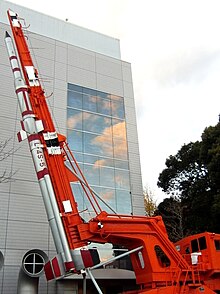
An expendable launch system is a launch vehicle that can be launched only once, after which its components are either destroyed during reentry or discarded in space. ELVs typically consist of several rocket stages that are discarded sequentially as their fuel is exhausted and the vehicle gains altitude and speed. As of October 2019, most satellites and human spacecraft are currently launched on ELVs. ELVs are simpler in design than reusable launch systems and therefore may have a lower production cost. Furthermore, an ELV can use its entire fuel supply to accelerate its payload, offering greater payloads. ELVs are proven technology in widespread use for many decades.
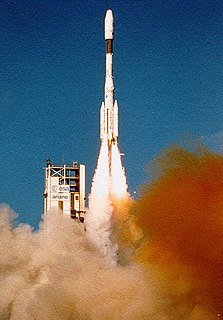
Ariane is a series of a European civilian expendable launch vehicles for space launch use. The name comes from the French spelling of the mythological character Ariadne. France first proposed the Ariane project and it was officially agreed upon at the end of 1973 after discussions between France, Germany and the UK. The project was Western Europe's second attempt to develop its own launcher following the unsuccessful Europa project. The Ariane project was code-named L3S.

The M-V rocket, also called M-5 or Mu-5, was a Japanese solid-fuel rocket designed to launch scientific satellites. It was a member of the Mu family of rockets. The Institute of Space and Astronautical Science (ISAS) began developing the M-V in 1990 at a cost of 15 billion yen. It has three stages and is 30.7 meters (101 ft) high, 2.5 meters in diameter, and weighs about 140 tonnes. It was capable of launching a satellite weighing 1.8 tonnes into an orbit as high as 250 km (160 mi).
The Kosmos-3M is a Russian space launch vehicle, member of the Kosmos rocket family. It is a liquid-fueled two-stage rocket, first launched in 1967 and with over 420 successful launches to its name. The Kosmos-3M uses UDMH fuel and AK27I oxidizer to lift roughly 1,400 kg (3,100 lb) of payload into orbit. It differed from the earlier Kosmos-3 in its finer control of the second-stage burn, allowing operators to tune the thrust and even channel it through nozzles that helped orient the rocket for the launching of multiple satellites at one time. PO Polyot has manufactured these launch vehicles in the Russian town of Omsk for decades. It was originally scheduled to be retired from service in 2011; however, in April 2010 the Commander of the Russian Space Forces confirmed that it would be retired by the end of 2010. One further launch, with Kanopus-ST, was planned; however, this was cancelled in late 2012 as the rocket had exceeded its design life while in storage ahead of the launch.
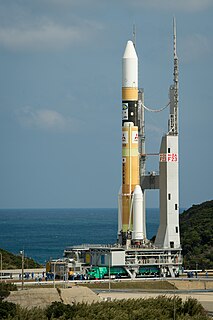
H-IIA (H-2A) is an active expendable launch system operated by Mitsubishi Heavy Industries (MHI) for the Japan Aerospace Exploration Agency. These liquid fuel rockets have been used to launch satellites into geostationary orbit; lunar orbiting spacecraft; Akatsuki, which studied the planet Venus; and the Emirates Mars Mission, which was launched to Mars in July 2020. Launches occur at the Tanegashima Space Center. The H-IIA first flew in 2001. As of November 2020, H-IIA rockets were launched 43 times, including 37 consecutive missions without a failure, dating back to 29 November 2003.

Geosynchronous Satellite Launch Vehicle (GSLV) is an expendable launch system operated by the Indian Space Research Organisation (ISRO). GSLV was used in thirteen launches from 2001 to 2018, with more launches planned. Even though GSLV Mark III shares the name, it is an entirely different launch vehicle.

The Scout family of rockets were American launch vehicles designed to place small satellites into orbit around the Earth. The Scout multistage rocket was the first orbital launch vehicle to be entirely composed of solid fuel stages. It was also the only vehicle of that type until the successful launch of the Japanese Lambda 4S in 1970.

The Uchinoura Space Center is a space launch facility in the Japanese town of Kimotsuki, Kagoshima Prefecture. Before the establishment of the JAXA space agency in 2003, it was simply called the Kagoshima Space Center (鹿児島宇宙空間観測所) (KSC). All of Japan's scientific satellites were launched from Uchinoura prior to the M-V launch vehicles being decommissioned in 2006. It continues to be used for suborbital launches, and has also been used for the Epsilon orbital launch vehicle. Additionally, the center has antennas for communication with interplanetary space probes.

Lambda is the name of a series of Japanese carrier rockets. It consisted of the types Lambda 2, LS-A, LSC-3, Lambda 3, Lambda 4 and LS-C, developed jointly by Institute of Industrial Science of University of Tokyo, Institute of Space and Astronautical Science of Tokyo University, and Prince Motor Company, which merged with Nissan in 1966.
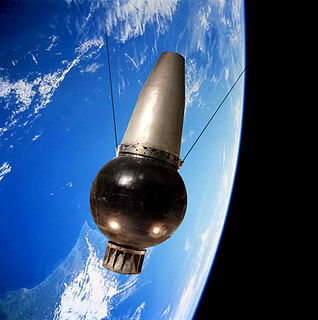
Ōsumi is the first Japanese satellite put into orbit. It was launched on February 11, 1970 at 04:25 UTC with a Lambda 4S-5 rocket from Uchinoura Space Center by Institute of Space and Aeronautical Science, University of Tokyo, now part of the Japan Aerospace Exploration Agency (JAXA). Japan became the fourth nation after the USSR, United States and France to release an artificial satellite into successful orbit on its own. The satellite is named after the Ōsumi Peninsula in Kagoshima Prefecture, Japan, where the launch site is located.
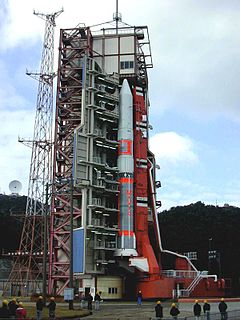
The Mu, also known as M, was a series of Japanese solid-fueled carrier rockets, which were launched from Uchinoura between 1966 and 2006. Originally developed by Japan's Institute of Space and Astronautical Science, Mu rockets were later operated by Japan Aerospace Exploration Agency following ISAS becoming part of it.
Institute of Space and Astronautical Science (ISAS) is a Japanese national research organization of astrophysics using rockets, astronomical satellites and interplanetary probes which played a major role in Japan's space development. Since 2003, it is a division of Japan Aerospace Exploration Agency (JAXA).

The Augmented Satellite Launch Vehicle or Advanced Satellite Launch Vehicle, also known as ASLV, was a Small-lift launch vehicle five-stage solid-fuel rocket developed by the Indian Space Research Organisation (ISRO) to place 150 kg satellites into LEO. This project was started by India during the early 1980s to develop technologies needed for a payload to be placed into a geostationary orbit. Its design was based on Satellite Launch Vehicle. ISRO did not have sufficient funds for both the Polar Satellite Launch Vehicle programme and the ASLV programme at the same time and the ASLV programme was terminated after the initial developmental flights. The payloads of ASLV were Stretched Rohini Satellites.
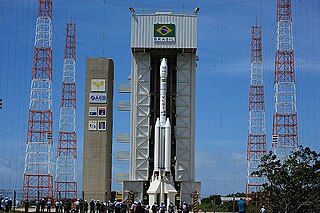
The VLS-1 was the Brazilian Space Agency's main satellite launch vehicle. The launch vehicle was to be capable of launching satellites into orbit. The launch site was located at the Alcântara Launch Center due to its proximity to the equator.

This comparison of orbital launch systems lists the attributes of all individual rocket configurations designed to reach orbit. A first list contains rockets that are currently operational or in development; a second list includes all retired rockets. For the simple list of all conventional launcher families, see: Comparison of orbital launchers families. For the list of predominantly solid-fueled orbital launch systems, see: Comparison of solid-fueled orbital launch systems.

The R-7 family of rockets is a series of rockets, derived from the Soviet R-7 Semyorka, the world's first ICBM. More R-7 rockets have been launched than any other family of large rockets.

The H–I or H–1 was a Japanese liquid-fuelled carrier rocket, consisting of a licence-produced American first stage and set of booster rockets, and all-Japanese upper stages. The H in the name represented the use of liquid hydrogen fuel in the second stage. It was launched nine times between 1986 and 1992. It replaced the N-II, and was subsequently replaced by the H–2, which used the same upper stages with a Japanese first stage.
Satellite Orbiting Rocket Number 420, or Pengorbitan-1, was a proposed space launch vehicle under consideration in Indonesia from 2008 to 2012. Recent developments have focused on a larger core stage called RX-420 and a smaller upper stage called RX-320, so this particular version RPS-420 is not being pursued any longer. However the goal remains valid: Indonesia aims to reach orbit with home-made rockets and satellites in order to become an Asian space power.

The Japanese space program originated in the mid-1950s as a research group led by Hideo Itokawa at the University of Tokyo. The size of the rockets produced gradually increased from under 30 cm (12 in) at the start of the project, to over 15 m (49 ft) by the mid-1960s. The aim of the original research project was to launch a man-made satellite.

The Epsilon Launch Vehicle, or Epsilon rocket, is a Japanese solid-fuel rocket designed to launch scientific satellites. It is a follow-on project to the larger and more expensive M-V rocket which was retired in 2006. The Japan Aerospace Exploration Agency (JAXA) began developing the Epsilon in 2007. It is capable of placing a 590 kg payload into Sun-synchronous orbit.
